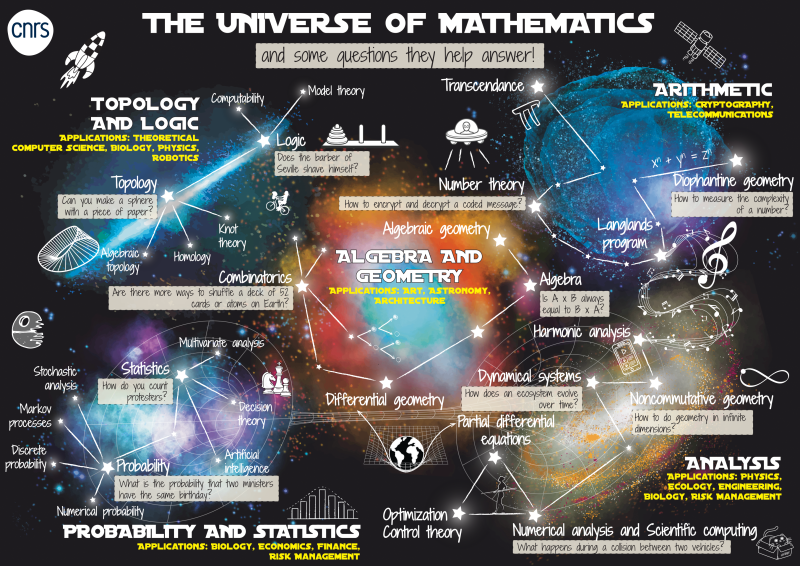"The Universe of Mathematics": A Map to Represent the Scope of Mathematical Research and Show Concrete Applications of the Discipline
How do we count protesters? What is the probability that two ministers share the same birthday? How can we encrypt and decrypt a message? Is it possible to make a sphere from a sheet of paper?
These are some of the questions that the "Universe of Mathematics" map aims to illustrate.
Created in 2023 by CNRS Mathematics (Insmi), this map visually represents the fields of mathematical research and demonstrates how mathematics addresses concrete questions in our daily lives.

Origins and Creation of the Universe of Mathematics Map
The idea for the Universe of Mathematics project emerged from the desire to compile and visually represent mathematical research, showcasing as many fields as possible.
" To create this map, the first step was to establish a relevant cartography of research areas in mathematics. We used several sources, such as the national synthesis and foresight on mathematics (2022) or the Mathematics Subject Classification (2020), which covers almost all research themes in mathematics (algebra, analysis, number theory, differential geometry, statistics, ...), " explains Christophe Delaunay.
A selection of research areas was chosen to make the map as accessible as possible.
Why a Map Representing Space?
"In a terrestrial map, borders are marked, whereas in mathematics, the borders are very diffuse": the universe is vast and allows passages between galaxies to avoid marking borders between research areas. A wormhole is also mentioned to represent these passages.
What Does the Universe of Mathematics Map Contain?
The map depicts 5 "major galaxies" of mathematics: topology and logic, arithmetic, algebra and geometry, probabilities and statistics, analysis.
In these galaxies, constellations and stars correspond to mathematical subjects: model theory, number theory, dynamical systems, differential geometry, probabilities, numerical analysis and scientific computing, decision theory, non-commutative geometry, discrete probability, etc.
In parallel, several thematic nods are found on the map, represented by drawings.
Additionally, thematic nods are found on the map, represented by drawings. For example, the constellation in the "Arithmetic" galaxy depicts an elliptical curve echoing the central field in number theory, the tightrope walker in the "Analysis" galaxy refers to control theory, and the musical score connects Langlands' program to harmonic analysis. The map also features the towers of Hanoi, Möbius strip, Earth deforming space-time, Schrödinger's cat, and more.
The map also highlights 11 concrete and mathematical questions.
Among them: Are there more ways to shuffle a deck of 52 cards or atoms on Earth? Does the Barber of Seville shave himself? How to measure the complexity of a number? What happens during a collision between two vehicles?
Does the Barber of Seville Shave Himself?
The Barber of Seville is the one who shaves all the people in his town who do not shave themselves. So, what happens to him?
This rule is unenforceable and refers to Russell's paradox: does the set of all sets that do not belong to themselves belong to itself?
If we say yes, then, as by definition the members of this set do not belong to themselves, it does not belong to itself: a contradiction. But if we say no, then it has the required property to belong to itself: a contradiction again. Thus, we have a contradiction in both cases, making the existence of such a set paradoxical.
How to Encrypt and Decrypt a Message?
Cryptography is the art of encrypting messages by implementing crypto systems.
There are two main families of cryptography: private key cryptography, where the encryption and decryption procedures are essentially the same and use a single secret, and public key cryptography. This family's principle is an encryption method that uses different keys: a public key to encrypt messages and a private key, held only by the message recipient, to decrypt. These systems, initiated in the 1970s, are widely used today, for example, in our bank cards, and have revolutionized our daily lives.
Cette carte est à destination des chercheuses et chercheurs en mathématiques pour leurs activités de diffusion, de l’écosystème large des mathématiques mais aussi du grand public et de tous les curieux.
